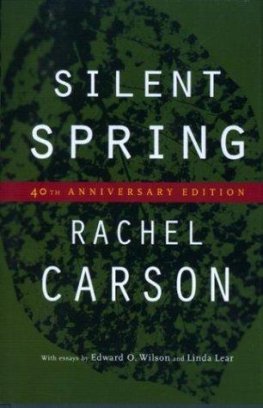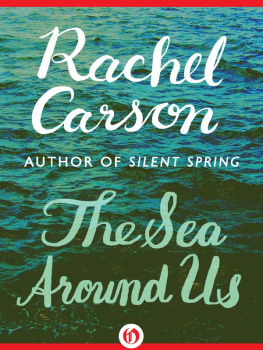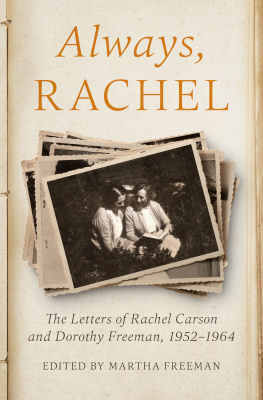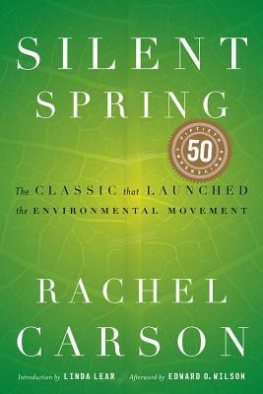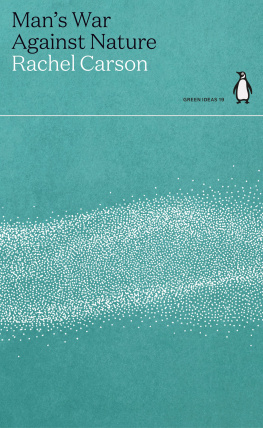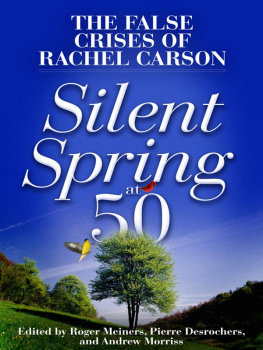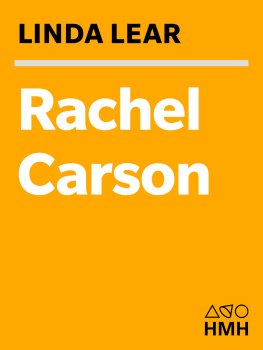Linda Lears collection of [Rachel Carsons] essays does a superb job of pulling from Carsons works a collection that is lyric, descriptive, informative and moving. This book should be required reading both for corporate managers in environmentally sensitive industries and for environmentalists and environmental scientists, who deserve the inspiration of Carsons finely wrought, passionate prose.
B ILL S HARP , The New York Times Book Review
With her unique capacity to fuse scientific precision and lyrical power, Rachel Carson introduced a worldwide audience both to the principles of ecology and to their ethical, aesthetic, and spiritual implications. This collection of Carsons writings over a span of forty-five years constitutes a stirring autobiography of the woman who became our centurys prophet of wonder.
J OHN E LDER , author of Reading the Mountains of Home
Linda Lears selections and commentary demonstrate eloquently how Silent Spring developed as the culmination of Rachel Carsons literary, scientific, and moral development. For those who would know more about Rachel Carson, or about the environmental movement in the United States, Lost Woods is an enriching book.
J UDY K ELLOGG M ARKOWSKY , Habitat
Touching all aspects of [Carsons] work are her puzzlings over the simple fact of life and her druidic appreciation of natural cycles and the beauty, excitement, and inscrutable elements of the natural world. [Her fans] will find in this collection an engaging glimpse into the breadth of Carsons curiosity and the fashioning of her public voice as a defender of the environment.
Kirkus Reviews
Carsons writings have a surprising currency. Her prescient warnings are as relevant today as they were when Carson wrote them.
A DELHEID F ISCHER , World
[ Lost Woods ] rounds out the portrait of one of the most significant people of this century.
Pittsburgh Magazine
Lost Woods adds to the wealth of [Carsons] laudable work for the planet.
The Earth Times
If fleeting sketches can sometimes say more than the fully realized work, this collection of journal entries, a TV script, speeches, and articles by one of the pioneers of the modern environmental movement gracefully delivers. The careful gathering of fragments by Lear (author of the 1997 biography Rachel Carson) gives rare glimpses of Carsons personal vulnerability and of her strange fusion of restraint and fervor, offering a frequent sense of being in Carsons company.
Publishers Weekly

Lost Woods
The Discovered Writing of Rachel Carson
E D I T E D A N D W I T H A N I N T R O D U C T I O N B Y
L I N D A L E A R
B E A C O N P R E S S
B O S T O N
To my loving husband
John W. Nickum, Jr.
and
With gratitude to
Ruth Brinkmann Jerome
and
Ruth Jury Scott
whose lives have so richly blessed my own
Contents
Rachel Carsons literary legacy is only four books. But those four books are enough to have changed how humankind regards the living world and the future of life on this earth. Her literary reputation rests primarily on two of them: The Sea Around Us (1951) and Silent Spring (1962), a book that changed the course of history.
The magnitude of Carsons impact on the publics understanding of such issues as ecology and environmental change still astonishes. Two volumes of her trilogy on the life of the sea, The Sea Around Us and The Edge of the Sea , were serialized in the New Yorker , and all three, including Under the Sea-Wind (1941), appeared on the New York Times best-seller list for months on end. The Sea Around Us maintained its place for a record eighty-six weeks and was eventually translated into more than forty languages. Silent Spring was also serialized in the New Yorker , making Carson the first woman writer to have three of her works introduced in its pages by 1962. It was translated into many languages, and still sells over 25,000 copies every year. Rachel Carson had garnered an international reputation as a natural scientist and public voice for the care of the earth by the time of her death in 1964. She was the most acclaimed science writer of her generation and a literary figure of first rank.
The purpose of Lost Woods , this collection of Carsons undiscovered and little known writing, is to give the reader what is missing from the more famous body of Carsons work a sense of her evolution as a natural scientist and a creative writer. Carsons unpublished and heretofore unknown literary output only heightens her importance as an environmental thinker. In this anthology, Carsons public and private voice speaks to our human condition and to the condition of our earth at the end of the millennium. Encompassing youthful writing, newspaper essays, field journals, speeches, articles, and letters, Lost Woods intimately reveals the intellectual process by which Carson became not just a literary celebrity, but one of the centurys most important writers and social commentators, whose call to alarm took us all in a new direction and was the catalyst for the contemporary environmental movement.
The pace and pressure of Rachel Carsons life mitigated against there ever being a large body of writing. By nature she worked slowly and methodically, unwilling to move from one sentence to another until the first met her syntactical and lyrical satisfaction. She revised endlessly, read everything out loud, and then had it read back to her until she was satisfied with its tone, alliteration, and clarity. A perfectionist in form and structure, Carson was also a meticulous researcher whose demand for accuracy was legendary among her government colleagues, assistants, and editors.
It was gratifying for me to learn that Carson never finished a manuscript or an article on time with the exception of the feature stories she wrote for the Baltimore Sun in the 1930s. But it was heartrending to piece together the nearly overwhelming burden of family responsibility and emotional demand that prevented her from achieving the corpus of work that she dreamed of producing, and had the talent and vision to create.
Beginning in the late 1930s, Carson supported herself, her mother, her sister, and later her sisters two daughters, and her grand-nephew whom she adopted in 1957. A fifteen-year career in the federal government as an aquatic biologist and editor relegated her writing to evenings and time snatched between weekend obligations, yet also deepened her experience of the living world and her commitment to preserving it.
The literary success of The Sea Around Us brought a measure of financial security and enabled Carson to devote all her time to her writing after 1952. She enjoyed only a few years of freedom before her mothers physical decline, her nieces death, and the needs of a young child again stole her creative time and taxed her emotional stamina. The last five years of Carsons life were a race against time and the course of terminal illness. Fighting a misdiagnosed and aggressive breast cancer, Carson endured the side effects of treatment and the ravages of what she called a catalogue of illnesses to complete Silent Spring and to defend it. What is remarkable is not that Carson produced such a small body of work, but that she was able to produce it at all.
Rachel Carson had plans for at least four other major works. She had been collecting material for a scientific study of evolution, and had a book contract for another, more philosophical examination of ecology. She had started to revise and expand an earlier magazine article on exploring the natural world with children, and she was intrigued by the new discoveries in atmospheric science and climate and hoped to write something in this emerging field. Carsons literary papers display a full range of topics that she had, in one way or another, committed herself to writing about, and many more that she hoped one day to have the time to pursue. But time ran out in April 1964.
Next page



